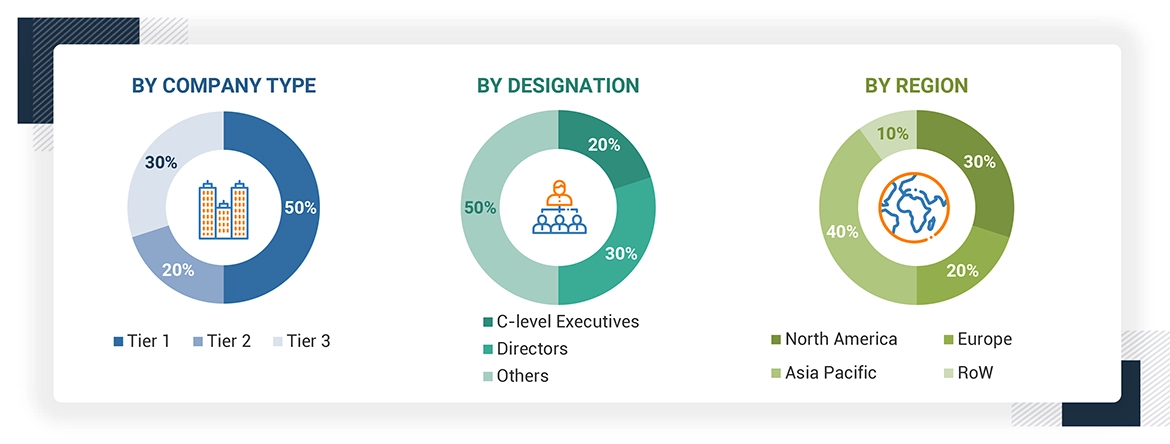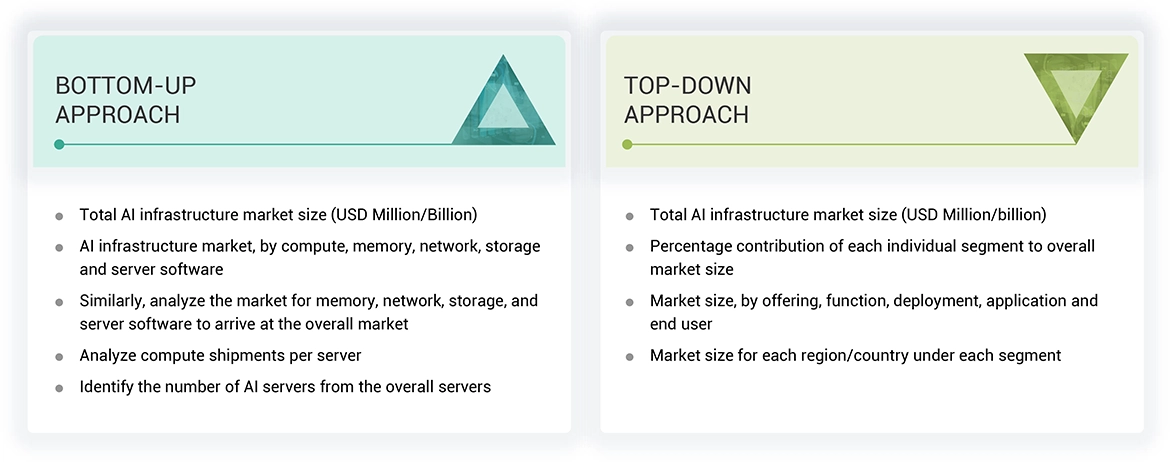The research process for this technical, market-oriented, and commercial study of the AI infrastructure market included the systematic gathering, recording, and analysis of data about companies operating in the market. It involved the extensive use of secondary sources, directories, and databases (Factiva, Oanda, and OneSource) to identify and collect relevant information. In-depth interviews were conducted with various primary respondents, including experts from core and related industries and preferred manufacturers, to obtain and verify critical qualitative and quantitative information as well as to assess the growth prospects of the market. Key players in the AI infrastructure market were identified through secondary research, and their market rankings were determined through primary and secondary research. This included studying annual reports of top players and interviewing key industry experts, such as CEOs, directors, and marketing executives.
Secondary Research
In the secondary research process, various secondary sources were used to identify and collect information for this study. These include annual reports, press releases, and investor presentations of companies, whitepapers, certified publications, and articles from recognized associations and government publishing sources. Research reports from a few consortiums and councils were also consulted to structure qualitative content. Secondary sources included corporate filings (such as annual reports, investor presentations, and financial statements); trade, business, and professional associations; white papers; Journals and certified publications; articles by recognized authors; gold-standard and silver-standard websites; directories; and databases. Data was also collected from secondary sources, such as the International Trade Centre (ITC) (Switzerland), and the International Monetary Fund (IMF).
List of key secondary sources
|
Source
|
Web Link
|
|
Generative AI Association (GENAIA)
|
https://www.generativeaiassociation.org/
|
|
Association for Machine Learning and Application (AMLA)
|
https://www.icmla-conference.org/
|
|
Association for the Advancement of Artificial Intelligence
|
https://aaai.org/
|
|
European Association for Artificial Intelligence
|
https://eurai.org/
|
|
International Monetary Fund
|
https://www.umaconferences.com/
|
|
Institute of Electrical and Electronics Engineers (IEEE)
|
https://ieeexplore.ieee.org/
|
Primary Research
Extensive primary research was accomplished after understanding and analyzing the AI infrastructure market scenario through secondary research. Several primary interviews were conducted with key opinion leaders from both demand- and supply-side vendors across four major regions—North America, Europe, Asia Pacific, and RoW. Approximately 30% of the primary interviews were conducted with the demand side, and 70% with the supply side. Primary data was collected through questionnaires, emails, and telephonic interviews. Various departments within organizations, such as sales, operations, and administration, were contacted to provide a holistic viewpoint in the report.

Note: Other designations include technology heads, media analysts, sales managers, marketing managers, and product managers.
The three tiers of the companies are based on their total revenues as of 2023 ? Tier 1: >USD 1 billion, Tier 2: USD 500 million–1 billion, and Tier 3: USD 500 million.
To know about the assumptions considered for the study, download the pdf brochure
Market Size Estimation
In the complete market engineering process, top-down and bottom-up approaches and several data triangulation methods have been used to perform the market size estimation and forecasting for the overall market segments and subsegments listed in this report. Extensive qualitative and quantitative analyses have been performed on the complete market engineering process to list the key information/insights throughout the report. The following table explains the process flow of the market size estimation.
The key players in the market were identified through secondary research, and their rankings in the respective regions determined through primary and secondary research. This entire procedure involved the study of the annual and financial reports of top players, and interviews with industry experts such as chief executive officers, vice presidents, directors, and marketing executives for quantitative and qualitative key insights. All percentage shares, splits, and breakdowns were determined using secondary sources and verified through primary sources. All parameters that affect the markets covered in this research study were accounted for, viewed in extensive detail, verified through primary research, and analyzed to obtain the final quantitative and qualitative data. This data was consolidated, supplemented with detailed inputs and analysis from MarketsandMarkets, and presented in this report.
AI Infrastructure Market : Top-Down and Bottom-Up Approach
Bottom-Up Approach
-
Initially, the companies offering AI infrastructure were identified. Their products were mapped based on offering, function, deployment, application, and end user.
-
After understanding the different types of AI infrastructure offering by various manufacturers, the market was categorized into segments based on the data gathered through primary and secondary sources.
-
To derive the global AI infrastructure market, global server shipments of top players for AI servers considered in the report's scope were tracked
-
A suitable penetration rate was assigned for computing, memory, network, storage, and server software offerings to derive the shipments of AI infrastructure.
-
We derived the AI infrastructure market based on different offerings using the average selling price (ASP) at which a particular company offers its devices. The ASP of each offering was identified based on secondary sources and validated from primaries.
-
For the CAGR, the market trend analysis was carried out by understanding the industry penetration rate and the demand and supply of AI infrastructure offerings for different end users.
-
The AI infrastructure market is also tracked through the data sanity method. The revenues of key providers were analyzed through annual reports and press releases and summed to derive the overall market.
-
For each company, a percentage is assigned to its overall revenue or, in a few cases, segmental revenue to derive its revenue for the AI Infrastructure. This percentage for each company is assigned based on its product portfolio and range of AI infrastructure offerings.
-
The estimates at every level, by discussing them with key opinion leaders, including CXOs, directors, and operation managers, have been verified and cross-checked, and finally, with the domain experts at MarketsandMarkets.
-
Various paid and unpaid sources of information, such as annual reports, press releases, white papers, and databases, have been studied.
Top-Down Approach
-
The global market size of AI infrastructure was estimated through the data sanity of major companies.
-
The growth of the AI infrastructure market witnessed an upward trend during the studied period, as it is currently in the initial stage of the product cycle, with major players beginning to expand their business into various application areas of the market.
-
Types of AI infrastructure offerings, their features and properties, geographical presence, and key applications served by all players in the AI infrastructure market were studied to estimate and arrive at the percentage split of the segments.
-
Different types of AI infrastructure offerings, such as compute, memory, and network, storage and server software and their penetration for end users were also studied.
-
The market split for AI infrastructure by offering, function, deployment, application, and end user was estimated based on secondary research.
-
The demand generated by companies operating in different end-use application segments was analyzed.
-
Multiple discussions with key opinion leaders across major companies involved in developing the AI Infrastructure offerings and related components were conducted to validate the offering, function, deployment, application, and end user market split.
-
The regional splits were estimated using secondary sources based on factors such as the number of players in a specific country and region and the adoption and use cases of each implementation type with respect to applications in the region.

Data Triangulation
After arriving at the overall size of the AI infrastructure market through the process explained above, the overall market has been split into several segments. Data triangulation procedures have been employed to complete the overall market engineering process and arrive at the exact statistics for all the segments, wherever applicable. The data has been triangulated by studying various factors and trends from both the demand and supply sides. The market has also been validated using both top-down and bottom-up approaches.
Market Definition
AI infrastructure refers to the foundational technological ecosystem required to develop, deploy, and scale artificial intelligence applications. It encompasses a combination of high-performance computing resources (e.g., GPUs, CPUs, FPGAs, etc.), memory solutions (e.g., DDR, HBM), networking components (e.g., network adapters, interconnects), software, and storage systems optimized for handling AI workloads. AI infrastructure supports both training and inference functions across diverse deployment models, including on-premises, cloud, and hybrid environments. It is utilized in generative AI, machine learning, natural language processing (NLP), and computer vision applications.
Key Stakeholders
-
Government and financial institutions and investment communities
-
Analysts and strategic business planners
-
Semiconductor product designers and fabricators
-
Application providers
-
AI solution providers
-
AI platform providers
-
AI system providers
-
Manufacturers and AI technology users
-
Business providers
-
Component and device suppliers and distributors
-
Professional service/solution providers
-
Research organizations
-
Technology standard organizations, forums, alliances, and associations
-
Technology investors
-
Investors (private equity firms, venture capitalists, and others)
Report Objectives
-
To define, describe, segment, and forecast the size of the AI infrastructure market, in terms of value, based on offering, function, deployment, application, end user, and region
-
To forecast the size of the market segments for four major regions—North America, Europe, Asia Pacific, and RoW
-
To define, describe, segment, and forecast the size of the AI infrastructure market, in terms of volume, based on offering.
-
To give detailed information regarding drivers, restraints, opportunities, and challenges influencing the growth of the market
-
To provide an value chain analysis, ecosystem analysis, case study analysis, patent analysis, Trade analysis, technology analysis, pricing analysis, key conferences and events, key stakeholders and buying criteria, Porter's five forces analysis, investment and funding scenario, and regulations pertaining to the market
-
To provide a detailed overview of the value chain analysis of the AI infrastructure ecosystem
-
To strategically analyze micromarkets1 with regard to individual growth trends, prospects, and contributions to the total market
-
To analyze opportunities for stakeholders by identifying high-growth segments of the market
-
To strategically profile the key players, comprehensively analyze their market positions in terms of ranking and core competencies2, and provide a competitive market landscape.
-
To analyze strategic approaches such as product launches, acquisitions, agreements, and partnerships in the AI infrastructure market
Available Customizations
With the given market data, MarketsandMarkets offers customizations according to the company’s specific needs. The following customization options are available for the report:
Company Information:
-
Detailed analysis and profiling of additional market players (up to 7)

Growth opportunities and latent adjacency in AI Infrastructure Market